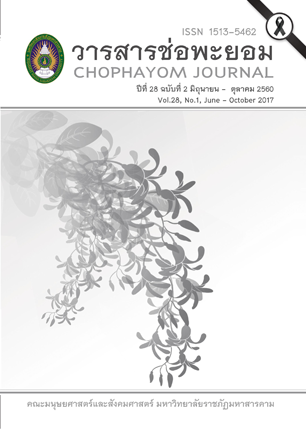สันนิษฐานนิทานที่เป็นต้นเค้าของนิทานเรื่องสังข์ทองของไทย The Assumption of the Origin of the Thai Folktale “San Thong”
Abstract
บทคัดย่อ
งานวิจัยนี้มีวัตถุประสงค์เพื่อสืบสันนิษฐานนิทานที่เป็นต้นเค้าของนิทานเรื่องสังข์ทองและศึกษาลักษณะของการเปลี่ยนแปลงที่เกิดขึ้นจากการแตกเรื่องของนิทาน ในการศึกษาได้รวบรวมนิทานของประเทศต่างๆ ที่มีความคล้ายคลึงกับนิทานเรื่องสังข์ทองของไทย โดยศึกษาจากเอกสาร งานวิจัยที่เกี่ยวข้อง และแหล่งข้อมูลออนไลน์แล้วนำข้อมูลที่รวบรวมได้มาวิเคราะห์ด้วยกระบวนวิธีการศึกษาเปรียบเทียบ ภายใต้กรอบแนวคิดเรื่องการแพร่ กระจายและการแตกเรื่องของนิทาน ผลการศึกษาสรุปได้ว่า นิทานสังข์ทองตอนที่ตัวละครเอกซ่อนตัวในหอยสังข์ น่าจะมีที่มาจากนิทานพื้นบ้านของจีน ส่วนตอนที่ พระสังข์ซ่อนตัวในรูปเงาะและหลังจากนั้นน่าจะมีที่มาจากนิทานอินเดียและอียิปต์ ทั้งนี้ การรับเอาเรื่องจากนิทานต้นเค้ามานั้น ได้มีการปรับเปลี่ยนเนื้อเรื่องบางประการ ที่สำคัญได้แก่ 1) การปรับเปลี่ยนตัวละครเอกให้เป็นพระโพธิสัตว์ 2) การปรับเปลี่ยนให้ตัวละครเอกซ่อนตัวในหอยสังข์ 3) การปรับเปลี่ยนให้ตัวละครเอกซ่อนตัวในรูปเงาะ 4) การเพิ่มจำนวนการทดสอบ และปรับเปลี่ยนวิธีการลงโทษหกเขย และ 5) การเพิ่มบทบาทของพระอินทร์ในตอนท้ายเรื่องโดยการปรับเปลี่ยนดังกล่าวเป็นไปเพื่อปรับให้เข้ากับบริบททางวัฒนธรรมไทย และช่วยเน้นย้ำแนวคิดสำคัญของเรื่องที่ว่า ควรให้ความสำคัญกับความดีงามภายในมากกว่ารูปลักษณ์ภายนอก คำสำคัญ : สันนิษฐานที่มาของนิทาน, นิทานสังข์ทอง, การแพร่กระจายของนิทาน
ABSTRACT
The objectives of this study were to investigate the origin of Thai folktale “Sang Thong” and the changing characteristics in the story due to its adaptation by the new cultures when it has spread from one culture to another. Folktales similar to Sang Thong from various societies were collected using valid sources such as published books, manuscripts, related research works and online, and were analyzed using methods of comparative study and diffusion theory of folktale. The result suggested that the first part of Sang Thong, when the main character “Phra Sang” sheltered in a conch, may have its origin from an early Chinese folktale. However, the latter part, when Phra Sang was disguised as a Sakai (an ethnic group living in southern Thailand and Malaysia region), was probably derived from Indian and Egyptian tales. In addition, there were significant adaptations in the story which were listed as following; 1) changing the main character to the Bodhisattva, 2) changing the protagonist to hide himself in the conch shell, 3) changing the protagonist to disguise as a Sakai, 4) increasing the number of the challenging tasks and changing the punishments of six son-in-law princes, and 5) adding the character of “Indra” as a helper. The story was adapted accordingly in order to harmonize with Thai cultural contexts and traditions. Moreover, the changesemphasized the idea of the inner beauty which was the main theme of the story. Keywords : Assumption of Folktale Origin, Sang Thong, Folktale Diffusion.




